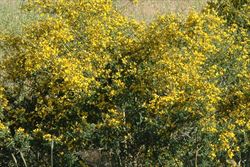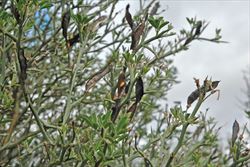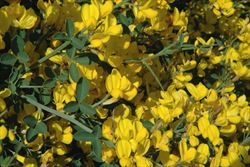Click on images to enlarge

infestation (Photo: Rob and Fiona Richardson)

habit in flower (Photo: Rob and Fiona Richardson)

habit in fruit (Photo: Rob and Fiona Richardson)

close-up of finely-ridged spiny stems (Photo: Rob and Fiona Richardson)

compound leaves with three leaflets and short branches ending in spines (Photo: Rob and Fiona Richardson)

flower clusters (Photo: Rob and Fiona Richardson)

pea-shaped flowers and young fruit beginning to develop (Photo: Rob and Fiona Richardson)

close-up of flower (Photo: Rob and Fiona Richardson)

mature fruit with seeds (Photo: Rob and Fiona Richardson)
Scientific Name
Calicotome spinosa (L.) Link
Synonyms
Calycotome spinosa LinkCytisus spinosus Lam.
Family
Fabaceae (Queensland, the ACT, Victoria, Tasmania and the Northern Territory)Fabaceae: subfamily - Faboideae (New South Wales)Leguminosae (South Australia)Papilionaceae (Western Australia)
Common Names
spiny broom, thorny broom
Origin
Native to the western Mediterranean region (i.e. northern Algeria, northern Libya, Italy, France and Spain).
Cultivation
Spiny broom (Calicotome spinosa) has been cultivated as a garden and hedging plant in the cooler temperate regions of southern Australia.
Naturalised Distribution
This species is not yet widely naturalised in Australia, and is currently restricted to the southern parts of Victoria.
It is also naturalised in New Zealand.
Habitat
A garden escape that has become naturalised in wetter temperate regions. It is a weed of open woodlands, grasslands, disturbed sites, fence lines, roadsides and pastures.
Habit
A much-branched and long-lived (i.e. perennial) shrub usually growing 1.5-2.5 m tall, but occasionally reaching up to 3 m in height.
Distinguishing Features
- a small shrub (1.5-3 m tall) with stems that are armed with sharp spines (up to 75 mm long).
- its compound leaves have three small leaflets and may be alternately arranged or clustered together on small side branches.
- the middle leaflet of each leaf is always slightly larger than the others (i.e. about 6-12 mm long).
- masses of bright yellow pea-shaped flowers (15-25 mm long) are borne singly or in small clusters near the ends of the branches.
- its flattened pods (25-40 mm long) have two distinctive ridges along one edge.
Stems and Leaves
The stems are much-branched from the base of the plant and greenish in colour. They are finely ridged lengthwise (i.e. striate) and are armed with many, sharp, rigid spines (up to 75 mm long). These spines may occasionally be branched.
The compound (i.e. trifoliate) leaves each have three small leaflets (mostly 5-10 mm long and 2-5 mm wide) that are dark green or greyish-green in colour. These leaflets are either oval (i.e. elliptic) or oblong in shape and the middle leaflet of each leaf is slightly larger than the others (i.e. about 6-12 mm long). The leaves are alternately arranged along the stems or clustered together on small side branches (or occasionally even found on the spines). They are borne on short stalks (i.e. petioles) and are sparsely hairy to moderately hairy (particularly on their undersides).
Flowers and Fruit
The numerous flowers are bright yellow and pea-shaped (12-25 mm long). They are borne singly or in small clusters on short stalks (i.e. pedicels) in the leaf forks (i.e. axils) near the ends of the branches. Flowering occurs mostly during late spring and early summer.
The fruit is a smooth, flattened pod (25-40 mm long) that ends in a short spine and has two distinctive ridges along one edge. These pods are either grey, black, or dark reddish-brown in colour and are hairless (i.e. glabrous). They are oblong to elongated (i.e. linear) in shape and contain 3-15 seeds. The smooth, rounded, seeds are brown or reddish-brown in colour (about 3 mm across) and have a shiny appearance.
Reproduction and Dispersal
This plant reproduces by seeds, which are spread small distances when the pods burst open. Seeds may be dispersed longer distances by animals, on machinery, in water, in soil, in contaminated agricultural produce or in dumped garden waste.
Environmental Impact
In Victoria, where it is regarded as a significant environmental weed, this species invades lowland grasslands, grassy woodlands and dry sclerophyll forests. It can form dense patches in these habitats and, like other brooms, spiny broom (Calicotome spinosa) may shade out understorey plants (i.e. ground covers, forbs and shrubs) and prevent the establishment of native species. As this species also fixes nitrogen, it can change nutrient levels in the soil.
Other Impacts
Dense patches of this species can limit access, of livestock, to watering points and reduce the productivity of pastures. They can also create a significant impediment to human access and provide harbour for pest animals. The biomass of the vegetation may increase where dense patches occur, leading to a possible increase in the intensity of fires. The large rigid spines on its stems can also cause injury to humans and livestock.
Legislation
This species is declared under legislation in the following states and territories:
- Victoria: C1 - a regionally controlled weed in the Port Phillip East region, where landholders must take all reasonable steps to control it and prevent its spread on their land and the roadsides which adjoin their land.
- Western Australia: Prohibited - on the prohibited species list and not permitted entry into the state.
Management
For information on the management of this species see the following resource:
- Parsons and Cuthbertson (1992), Noxious Weeds of Australia, pp. 467-468.
Similar Species
Spiny broom (Calicotome spinosa) is very similar to broom (Cytisus scoparius subsp. scoparius), gorse (Ulex europaeus), flax-leaf broom (Genista linifolia), Montpellier broom (Genista monspessulana) and Madeira broom (Genista stenopetala) at a distance, as these are all shrubs that produce masses of yellow pea-shaped flowers. However, these species can be distinguished by the following differences:
- spiny broom (Calicotome spinosa) is a spiny plant with compound (i.e. trifoliate) leaves that have three small leaflets (5-12 mm long). Its pods are relatively large (25-40 mm long), flattened, hairless (i.e. glabrous) and end in a small spine.
- broom (Cytisus scoparius subsp. scoparius) is a spineless plant with compound (i.e. trifoliate) leaves that have three relatively small leaflets (5-20 mm long). Its pods are relatively large (25-70 mm long), flattened, and have hairs along their edges (i.e. they are pubescent).
- gorse (Ulex europaeus) is a spiny plant and the mature plants tend to lack any true leaves, instead bearing narrow spine-like 'leaves' in clusters along the stems. Its pods are relatively small (10-25 mm long), oblong or egg-shaped (i.e. ovoid), and densely covered in long hairs (i.e. they are pubescent).
- flax-leaf broom (Genista linifolia) is a spineless plant with compound (i.e. trifoliate) leaves that have three relatively large, narrow, leaflets (20-30 mm long). Its pods are relatively small (15-30 mm long) and covered in silky or downy hairs (i.e. they are pubescent).
- Montpellier broom (Genista monspessulana) is a spineless plant with compound (i.e. trifoliate) leaves that have three relatively large, broad, leaflets (5-30 mm long). Its pods are relatively small (10-25 mm long) and densely covered in silky or downy hairs (i.e. they are pubescent).
- Madeira broom (Genista stenopetala) is a spineless plant with compound (i.e. trifoliate) leaves that have three relatively large, broad or narrow, leaflets (10-25 mm long). Its pods are relatively small (13-30 mm long) and densely covered in downy hairs (i.e. they are pubescent).

